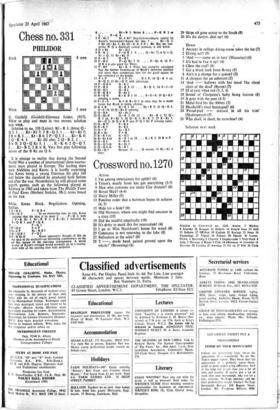Chess no. 331
PHILIDOR
G. Guidelli (Guidelli-Ellerman folder, 1917).
White to play and mate in two moves; solution next week.
Solution to no. 330 (Leites): Kt - R 3, threat Q-
Q 5. 1 ... Kt - Kt 7; 2 B - Q 5. 1 . . . Kt - Kt 5;
2 B X B. 1 ... Kt - B 4; 2 P - Q 5. 1 ... Kt -K 4;
2 Q -K 4. 1 . . . Kt (6) else; 2 Q - B 2. 1 . . .
B X B; 2 Q-Q Kt 5. 1 R-K 4; 2 Q-Q 7.
I ... Kt - B 2; 2 R x R. Very fine play following moves of the B Kt on Q 6.
It is strange to realise that during the Second World War a number of international chess tourna- ments were played in Europe. The leading stars were Alekhine and Keres; it is hardly surprising that Keres being a young Estonian his play fell
well below the standard he produced both before and after the war. Nevertheless he still played some superb games, such as the following played at Salzburg in 1943 and taken from The Middle Years of Paul Keres (Herbert Jenkins, 30s.); notes based
on his run.
White, Keres. Black, Bogoljubow. Opening, Sicilian. 1 P- K 4 P- Q B 4 2 Kt - K 2 . . . In an interesting note on this. Keres explains that his idea is to meet 2 . . . P - Q 3; with 3 P - K Kt 3, Kt - K B 3; 4 B - Kt 2 followed by P-Q B 3 and P-Q 4. P - K 3 P - Q 4 P x P3
4 Kt x P Kt - K B 3 5 Kt -QB 3 P-Q 3
6 P - K Kt 4! . . Keres apparently thought of this on
the spur of the moment-an interesting commentary on the ad hot nature of the war-time tournament. A world master of Keres's strength would normally go to a tourna- ment with all his opening lines fully prepared. Kt - Bt 3. Better 6 . . . e- K R 3 ex i. . P - K 4. 7 P - Kt 5 Kt X Kt? Bogoljubow-clearly rattled by Keres's innovation-feared the line 7 . . . Kt - Q 2;
8 Kt (4)- Kt 5.- Kt (2) - K 4; 9 P -, B4. But the text.
8 giving W Q a dominant central position, is still worse.
Q x t Kt - 2 9 B - K 3 . P - Q R 3 9 . . . Q - Kt 3?; 6 Q x Q, Kt x 0; 11 Kt -Kt 51 10 B - K 2 Q - B 2 II P - B 4 p- Q Kt 3 11 . . . P - Kt 4; 12 P- Q R 4 is also good for White. 12 P - B5t Kt - K 4 White has correctly calculated that the further breaking-up of Black's defensive position will more than compensate him for the good- square he has conceded to the knight. 13 P x P P x P 13 . . . B X P; 14 Q- R 4 ch, B - Q 2; 15 Kt - Q 5! with advantage. 14 P - Q R 4 B - K 2
16 15 P- Q 2 Q - B R 4 Q-B 2 4 15 .. . B-Q I; 16 0-0-0! Q
17 R-KB1 B - Kt 2 18 B - Q 4! R-K B 1 18 ... 0-0-0; 19 Q-K31 winning a pawn. 190- 0- 0 R x R B - Q 1 at once may be a shade better but Black is losing anyway. 20RxR B-Q 1 20 ... Kt-B 5: 21 Q-B 4. 0 - 0 - 0; 22 Q - Kt 4! winning. 21 Q - B 4 Kt - Kt 3 22 Q - Kt 4! Q-K 2 Or 22 .. Kt-B I: 23 0-
R 5 eh, P - Kt 3; 24 Q - R 6, B.- K 2: 25 B - Kt 7, Kt - 0 2; 26 0 x R P and 27 Q X Kt P winning easily.
23 Q - R 5! P - K 4 24 B - K 3 B - B 2 25 Q x P Kt - B 5 26 B x Kt PXB 27 B - R 5 ch K - Q 2 28 B-Kt4ch K-B 3 or 28 ...K-K 1: 29 R X P. 29 Q - B 5 P - Kt 4 30 Q - Q 5 ch K - Kt 3 31 Q - Q 4 els K - B 3 32 Kt - Q 5 Resigns 32 . . . Q moves; 33 Kt - Kt 4 mate.






































 Previous page
Previous page